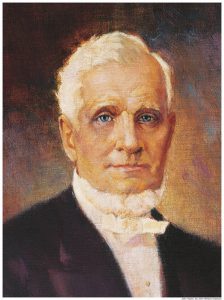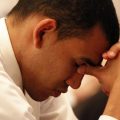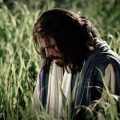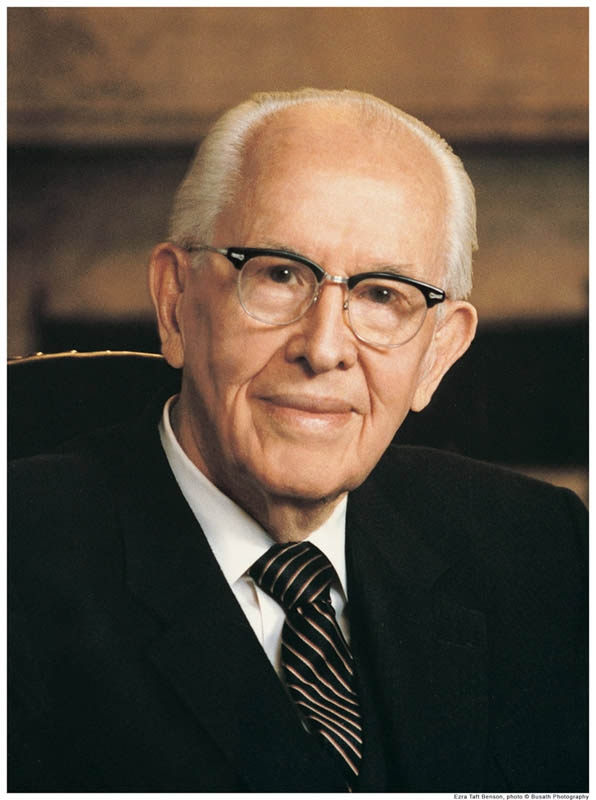John Taylor, third prophet of the Mormon Church, was born in the Westmoreland part of England in 1808. His parents were his first teachers, helping him learn to read. They also gave him faith in God and an understanding of the Bible and of the Savior. He was baptized as an infant into the Church of England.
However, when he was a little boy, he had a vision. He saw a man holding a trumpet in his mouth. The man was in the heavens and the trumpet was an announcement of some sort, but he didn’t understand what this meant. As a child, when he was alone, he frequently heard soft music that seemed to be coming from heaven. He kept all these things in his heart.
When he was sixteen, he converted to the Methodist religion and only a year later was made a lay preacher. He had strong spiritual impressions that God intended him to teach the gospel in the United States some day.
However, it wasn’t to the United States that he moved first. First, he immigrated to Toronto, Canada. His family went ahead and he joined them when he finished selling the family property and wrapping up business. On the ship, he received another spiritual prompting as God continued to prepare him for what was to come. A terrible storm arose, frightening everyone. However, John felt the spirit tell him again he must someday go to the United States to preach the gospel. Because of this, he knew he would arrive safely, and was so sure he even went up on deck to enjoy the storm that was terrifying his shipmates.
He lived in New York for a few months on his arrival and then joined his family in Canada, where he soon married another Canadian immigrant, Leonora Cannon. John Taylor was still deeply committed to religion and he and a group of people decided to get together regularly to study religion. Their study turned out to be unsettling. He later wrote, “A number of us met together for the purpose of searching the Scriptures; and we found that certain doctrines were taught by Jesus and the Apostles, which neither the Methodists, Baptists, … nor any of the religious sects taught; and we concluded that if the Bible was true, the doctrines of modern Christendom were not true; or if they were true, the Bible was false. … In addition … , we prayed and fasted before God; and the substance of our prayers was, that if he had a people upon the earth anywhere, and ministers who were authorized to preach the Gospel, that he would send us one” (in Journal of Discourses, 23:30).”
During this time, God was busy setting eternal history into motion and answering John Taylor’s hope that the truth would find him. Back in the United States, Parley P. Pratt was preparing for a mission to Toronto, Canada. The decision to go had not been easy because his wife was very ill and his financial situation was perilous. His house had burnt down a year ago as well. It was certainly not the best time to leave his home and family to serve a mission. (In the early days of the church, married men often served missions without their families. Today, this is done by unmarried young people or older couples.) Despite the hardship, though, Elder Heber C. Kimball had been filled with a strong spiritual impression that it was important he go and that there were people waiting for the gospel there. Without hesitation, he went.
At first, he might have wondered about that prophecy, because his many petitions for a place to preach were denied and no one wanted to hear his message. Then he met John Taylor. John was not really interested in the message, having heard many strange rumors about this “American” church. However, he listened politely, both because he was a courteous man and because he was interested in religion, still being a lay minister and still searching for that true religion. As Elder Pratt prepared to leave, a neighbor came by and invited the missionary to stay in her home and to preach their to the study group John and the neighbor belonged to.
It was Elder Pratt’s discussion of the Holy Ghost that captured his attention. Elder Pratt explained that it was through the Holy Ghost we could know what was true. John Taylor asked if the Holy Ghost would tell him if this Mormon religion was true and Elder Pratt assured him the Holy Ghost would and that it was the sure way to know. John agreed to put the religion to the test, but warned Elder Pratt that if the Holy Ghost said it was false, he would expose it to the world. However, if the Holy Ghost said it was true, John would join the church at any cost. For him, finding God’s truth was essential.
The others in the group found Elder Pratt was teaching many of the things they had found themselves in the Bible that other churches did not teach. However, the Book of Mormon proved a stumbling block for many. Some refused to learn any more and the others were hesitant. John spoke firmly, displaying the courage and integrity he would come to be known for:
“We are here, ostensibly in search of truth. Hitherto we have fully investigated other creeds and doctrines and proven them false. Why should we fear to investigate Mormonism? This gentleman, Mr. Pratt, has brought to us many doctrines that correspond with our own views. … We have prayed to God to send us a messenger, if He has a true Church on earth. Mr. Pratt has come to us … without purse or scrip, as the ancient apostles traveled; and none of us are able to refute his doctrine by scripture or logic. I desire to investigate his doctrines and claims to authority. … If I find his religion true, I shall accept it, no matter what the consequences may be.”
John began to study the Mormon religion and to pray. He began listening to Elder Pratt preach in a variety of places. He recorded the contents of eight different sermons and then went home to compare what was taught to what was in his Bible.
He almost hoped it would not be true, because he knew how dangerous his life would become if it were true. He was an honorable man and knew he had to do whatever God told him was right; he had always been that sort of person.
Soon he had a very sure knowledge that it was indeed true. He kept his promise and joined, prepared to accept any consequence that occurred as a result. The costs were indeed great and the strength of his testimony would be called on to support him many times. He was with Joseph Smith when the Joseph was murdered. John was shot and fell to the ground. While trying to get under a bed (they were in prison being held on false charges) he was shot again in the chest, but the bullet hit the watch in his pocket, saving his life. He was shot several more times, but lived. Joseph Smith was murdered. John’s life would be in danger from the government and others many more times in the future.
“I expected when I came into this church, that I should be persecuted and proscribed. I expected that the people would be persecuted. But I believed that God had spoken, that the eternal principles of truth had been revealed, and that God had a work to accomplish which was in opposition to the ideas, views, and notions of men, and I did not know but it would cost me my life before I got through. … If they killed Jesus in former times, would not the same feeling and influence bring about the same results in these times? I had counted the cost when I first started out, and stood prepared to meet it.
The Lord, through simple means, is able to take care of and deliver his people, but they must put implicit faith and confidence in him; and when they are crowded into a tight place they must not be afraid to make sacrifice for the sake of maintaining the truth, and all will be well with us whether living or dying, in time or in eternity.(Chapter 23: Eternal Truth,” Teachings of Presidents of the Church: John Taylor, 209.)
John used his talents to serve God in a variety of ways. He converted many of his neighbors and then moved to the United States to live in the Mormon community. He became an apostle when he was thirty years old. He wrote many articles explaining Mormonism, edited a newspaper, and became known among church members as the Defender of the Faith. He served four full-time missions, and one was to New York, fulfilling the prophecies he had received most of his life about preaching the gospel in the United States.
He would become the third president of the Church during very difficult times in church history. During this time as president, he organized the priesthood, set up the concept of regular stake conferences (stakes are similar to dioceses) and organized an auxiliary for children called Primary. He fought for the principal of religious freedom during a time the government wanted to disenfranchise the church and confiscate their property. This would have allowed the government to effectively end religious freedom for all religions, who would be forced to alter their doctrines to meet the current fads of the government in order to be allowed to practice, and this, of course, would have been a powerful threat to the constitution.
John Taylor is the only prophet who was born outside the United States to date. Having come from an autocratic nation, loved the American form of government and fought long and hard to preserve it. He invited people to celebrate and protect freedom of religion.
About Terrie Lynn Bittner
The late Terrie Lynn Bittner—beloved wife, mother, grandmother, and friend—was the author of two homeschooling books and numerous articles, including several that appeared in Latter-day Saint magazines. She became a member of the Church at the age of 17 and began sharing her faith online in 1992.







